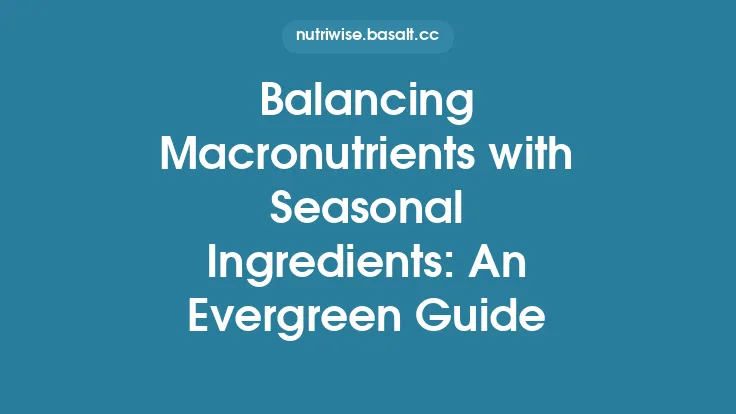Maintaining food freshness without relying on synthetic additives or single‑use plastics is both a timeless practice and a modern sustainability imperative. By turning to natural preservation techniques, households can extend the edible life of seasonal harvests, reduce waste, and lower the environmental footprint associated with industrial processing. This article explores the underlying science, a range of proven methods, and practical steps for integrating these techniques into an eco‑friendly kitchen routine.
The Science of Natural Preservation: How It Works
Natural preservation hinges on three fundamental principles: inhibition of microbial growth, control of enzymatic activity, and reduction of oxidative reactions.
- Microbial Inhibition – Bacteria, yeasts, and molds require water, nutrients, a suitable pH, and a hospitable temperature to proliferate. By altering any of these parameters—through acidity, salinity, dehydration, or competitive fermentation—microorganisms are either slowed or rendered inactive.
- Enzymatic Control – Enzymes native to food tissues catalyze ripening and decay. Lowering temperature, reducing oxygen exposure, or introducing natural enzyme inhibitors (e.g., certain phenolic compounds) can delay these processes.
- Oxidation Prevention – Lipid oxidation leads to rancidity and off‑flavors. Antioxidant compounds found in herbs, spices, and certain oils (e.g., tocopherols in wheat germ oil) scavenge free radicals, preserving flavor and nutritional quality.
Understanding these mechanisms allows the cook to select the most appropriate technique for a given ingredient, balancing flavor development with longevity.
Fermentation: Harnessing Microbial Power
Fermentation is arguably the most versatile natural preservation method. By encouraging the growth of beneficial microorganisms—primarily lactic acid bacteria (LAB), yeasts, and certain molds—food is transformed into a stable, flavorful product.
- Lactic Acid Fermentation – Vegetables such as cabbage, carrots, and radishes are submerged in a brine (typically 2–5 % NaCl). LAB convert sugars into lactic acid, dropping the pH to 3.5–4.0, a range hostile to spoilage microbes. The resulting product, from sauerkraut to kimchi, can be stored for months at refrigerator temperatures or even at ambient cool temperatures in traditional earthen crocks.
- Yeast Fermentation – Fruit juices and grain mash can be fermented into alcoholic beverages or vinegar. Ethanol production, followed by oxidation to acetic acid, creates an acidic environment that preserves the substrate while imparting complex flavors.
- Mold Fermentation – Certain cheeses and fermented soy products (e.g., tempeh) rely on molds such as Penicillium or Rhizopus to develop texture and taste while simultaneously inhibiting spoilage organisms.
Key considerations for safe fermentation include using clean, non‑reactive vessels (ceramic crocks, food‑grade wooden barrels, or stainless steel), maintaining appropriate salt concentrations, and monitoring temperature (typically 18–22 °C for LAB).
Pickling: Acidic Environments for Longevity
Pickling creates an inhospitable environment for microbes by immersing food in a high‑acid solution. Two primary approaches exist:
- Vinegar Pickling – A mixture of distilled white vinegar (5 % acetic acid), water, salt, and optional sugar is heated, then poured over vegetables, fruits, or even proteins. The final pH is usually ≤ 3.5, which halts bacterial growth. Adding spices (mustard seeds, dill, peppercorns) not only enhances flavor but introduces natural antimicrobial compounds such as allyl isothiocyanate from mustard.
- Lacto‑Fermented Pickling – As described above, this method relies on LAB to generate lactic acid in situ, eliminating the need for added vinegar. The resulting pickles often retain a brighter, more complex flavor profile.
Both methods benefit from sealed, low‑oxygen storage to prevent mold formation. Historically, sealed stoneware jars or wooden barrels with tight-fitting lids have been used; modern equivalents include food‑grade ceramic crocks with water‑sealed lids, which maintain a hermetic environment without plastic components.
Drying and Dehydration: Removing Moisture
Water is the primary medium for microbial activity. By reducing water activity (a_w) to below 0.6, most bacteria, yeasts, and molds cannot grow. Drying can be achieved through several low‑impact techniques:
- Sun Drying – In arid climates, thinly sliced fruits, vegetables, herbs, or fish can be placed on clean screens or woven mats. Rotating the trays periodically ensures even drying and prevents mold hotspots.
- Solar Dehydrators – Constructed from reclaimed wood and transparent glazing, these devices concentrate solar heat while allowing airflow, achieving temperatures of 45–60 °C.
- Low‑Temperature Oven or Food‑Dryer – Using a conventional oven set to its lowest setting (≈ 50 °C) or a purpose‑built dehydrator, foods can be dried uniformly. The key is to maintain a gentle airflow to carry away evaporated moisture.
- Air‑Drying in Controlled Environments – For herbs and leafy greens, hanging bundles in a well‑ventilated, low‑humidity room (a “drying loft”) preserves aromatic oils while reducing water content.
Properly dried foods are stored in airtight, moisture‑proof containers (e.g., sealed ceramic jars or reclaimed wooden boxes lined with natural parchment) to prevent reabsorption of humidity.
Sugar and Salt Curing: Osmotic Preservation
Both sugar and salt act as osmotic agents, drawing water out of cellular structures and creating an environment where microbes cannot thrive.
- Salt Curing – Meats, fish, and some vegetables are rubbed with a dry salt mixture (often combined with herbs, spices, and sometimes nitrates for color stability). The salt penetrates the tissue, reducing a_w and inhibiting bacterial growth. Traditional methods include dry‑cured ham, gravlax (cured salmon), and pickled cucumbers.
- Sugar Curing – High concentrations of sugar (or honey) are used for fruits, certain meats, and even some vegetables. The high osmotic pressure limits microbial activity while also providing a sweet flavor profile. Jam‑making, for instance, relies on sugar to both preserve and gel the fruit.
Both techniques can be combined (e.g., a “sweet‑salty” cure for pork ribs) to balance flavor and preservation efficacy. After curing, foods are typically rinsed to remove excess salt or sugar and then stored in cool, dark conditions.
Natural Antimicrobial Coatings: Wax, Oil, and Plant Extracts
Applying a thin, edible coating can create a physical barrier that limits oxygen exposure and moisture loss while delivering antimicrobial compounds.
- Beeswax and Carnauba Wax – Melted wax applied to the surface of cheeses, fruits, or cured meats forms a semi‑impermeable film. The wax slows oxidation and moisture migration, extending shelf life.
- Edible Oils – Lightly brushing nuts, seeds, or dried fruits with high‑oleic oils (e.g., avocado or olive oil) creates a protective layer that reduces surface drying and inhibits mold. Adding a few drops of rosemary or thyme essential oil introduces natural phenolics with antimicrobial activity.
- Plant‑Based Extracts – Solutions of clove oil, oregano oil, or green tea catechins can be sprayed onto produce or packaged foods. These extracts possess strong antibacterial and antifungal properties, often comparable to synthetic preservatives.
When using coatings, it is essential to apply them uniformly and store the coated items in a cool, dark place to prevent rancidity of the oils or waxes.
Temperature‑Controlled Environments: Root Cellars and Earth Ovens
Beyond chemical methods, controlling temperature and humidity is a cornerstone of natural preservation.
- Root Cellars – Underground or partially buried chambers maintain temperatures between 0–10 °C with relative humidity of 85–95 %. This environment slows enzymatic activity and microbial growth, making it ideal for storing root vegetables (potatoes, carrots), apples, and certain fermented products. Insulating the cellar with straw, sawdust, or reclaimed timber enhances temperature stability.
- Earth Ovens (Pit Ovens) – By burying food in a pit lined with stones and covering it with earth, heat is retained for extended periods, effectively “cooking” and preserving foods such as tubers, beans, or whole chickens. The slow, low‑temperature cooking reduces moisture content and creates a sealed environment that limits spoilage.
- Cool‑Room Storage – Repurposing a well‑insulated pantry or a small, insulated shed as a cool room can mimic cellar conditions without excavation. Adding a natural ventilation shaft (a simple wind‑catcher) helps regulate temperature and humidity passively.
These passive storage solutions rely on the earth’s thermal mass and require minimal energy, aligning perfectly with eco‑friendly goals.
Integrating Natural Techniques with Eco‑Friendly Packaging
While the preservation method does the heavy lifting, packaging plays a supporting role in protecting the product from external contaminants and physical damage. Sustainable packaging options that complement natural preservation include:
- Ceramic or Stoneware Vessels – Non‑porous, inert, and reusable, these containers can be sealed with natural wax lids or fitted with water‑sealed clay lids, creating an anaerobic environment ideal for fermentation and pickling.
- Reclaimed Wood Boxes – Lined with parchment or natural fibers, wooden crates provide a breathable yet protective environment for dried herbs, grains, and root cellar produce.
- Biodegradable Plant‑Fiber Bags – For storing dehydrated fruits or nuts, bags made from hemp, jute, or cotton can be sealed with a natural twine drawstring, offering a low‑impact alternative to plastic pouches.
- Glassine or Wax‑Coated Paper – Thin, moisture‑resistant sheets can wrap cured meats or cheese wedges, providing a barrier without the need for synthetic plastics.
Choosing packaging that does not interfere with the preservation chemistry (e.g., avoiding reactive metals that could catalyze oxidation) ensures the longevity and safety of the stored food.
Safety, Quality, and Shelf‑Life Considerations
Natural preservation does not eliminate the need for vigilance. Key safety checkpoints include:
- pH Monitoring – For fermented and pickled foods, a pH ≤ 4.6 is generally considered safe against Clostridium botulinum. Simple pH strips or a calibrated meter can verify acidity.
- Water Activity (aw) Testing – While specialized meters are optional, a rule of thumb is that aw below 0.6 significantly limits microbial growth. Observing texture (e.g., crispness of dried herbs) can serve as a practical proxy.
- Temperature Control – Maintaining consistent cool temperatures (0–10 °C for long‑term storage) prevents unwanted microbial proliferation and enzymatic breakdown.
- Visual and Olfactory Checks – Discoloration, off‑odors, or visible mold indicate spoilage. Even natural preservatives can fail if storage conditions deviate.
- Batch Documentation – Recording the date of preparation, method, and storage conditions helps track shelf life and identify any recurring issues.
Typical shelf lives, when all parameters are met, are:
| Preservation Method | Approximate Shelf Life (Ideal Conditions) |
|---|---|
| Lactic acid fermentation (vegetables) | 6–12 months |
| Vinegar pickling (vegetables) | 12–18 months |
| Salt‑cured meats (dry‑cured) | 6–12 months |
| Sugar‑cured fruits (jams) | 12–24 months |
| Dehydrated herbs & fruits | 12–24 months |
| Wax‑coated cheeses | 3–6 months |
| Root cellar stored root veg | 6–12 months |
These timelines assume proper sealing, cool storage, and absence of contamination.
Building a Sustainable Preservation Routine
- Seasonal Planning – Identify peak harvest periods for local produce. Allocate a weekend to harvest, clean, and sort items for preservation.
- Method Matching – Pair each ingredient with its most suitable natural technique (e.g., tomatoes → sun‑drying or vinegar pickling; leafy greens → fermentation into kimchi).
- Equipment Audit – Gather reusable, non‑plastic tools: ceramic crocks, stone mortars, wooden pestles, stainless steel strainers, and natural cloths for handling.
- Batch Processing – Work in manageable batches to avoid over‑processing, which can lead to quality loss.
- Documentation & Labeling – Use reclaimed paper labels with ink made from natural pigments (e.g., walnut husk) to note preparation date, method, and expected shelf life.
- Continuous Learning – Keep a small notebook of observations—flavor development, texture changes, any spoilage incidents—to refine techniques over successive seasons.
By embedding these steps into regular kitchen practice, the household not only reduces reliance on industrial preservatives and plastic packaging but also cultivates a deeper connection to the food cycle, honoring both tradition and ecological responsibility.





